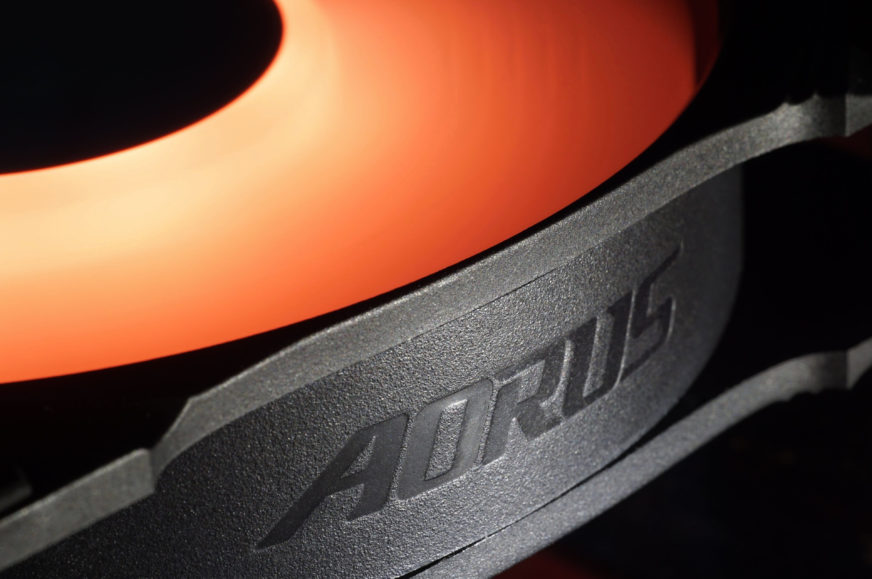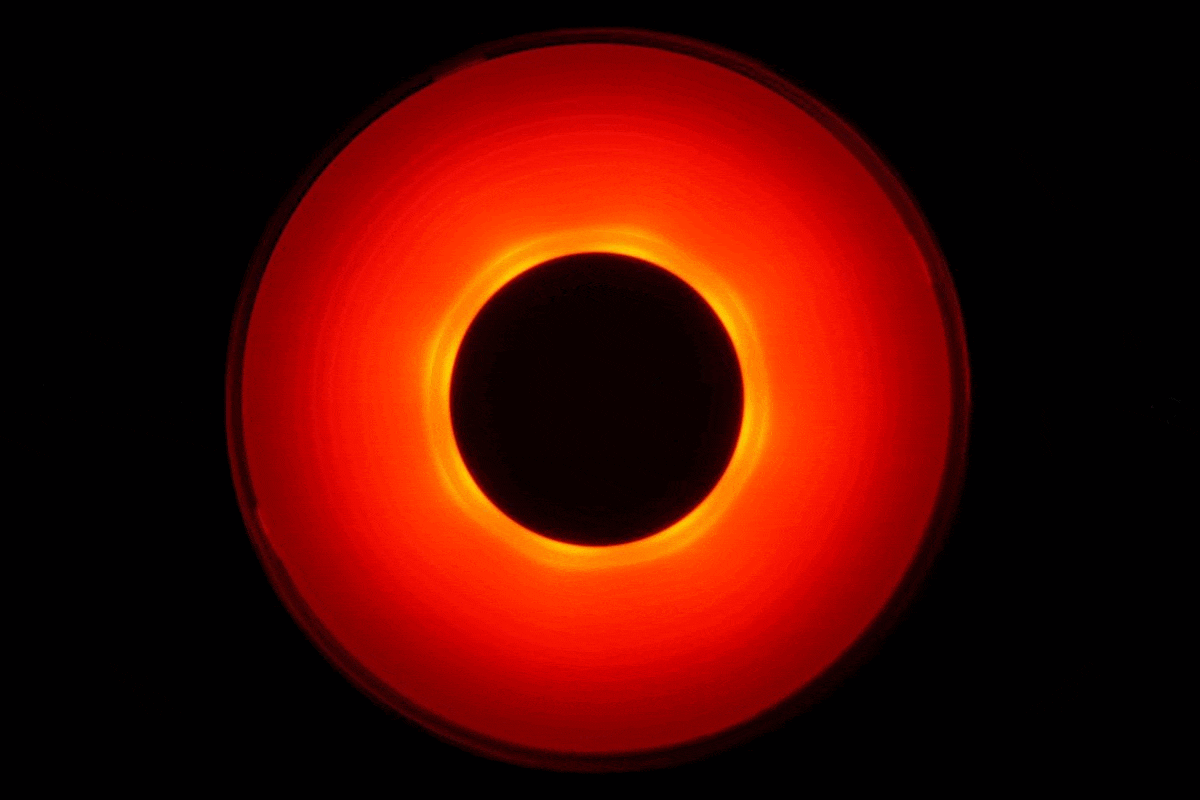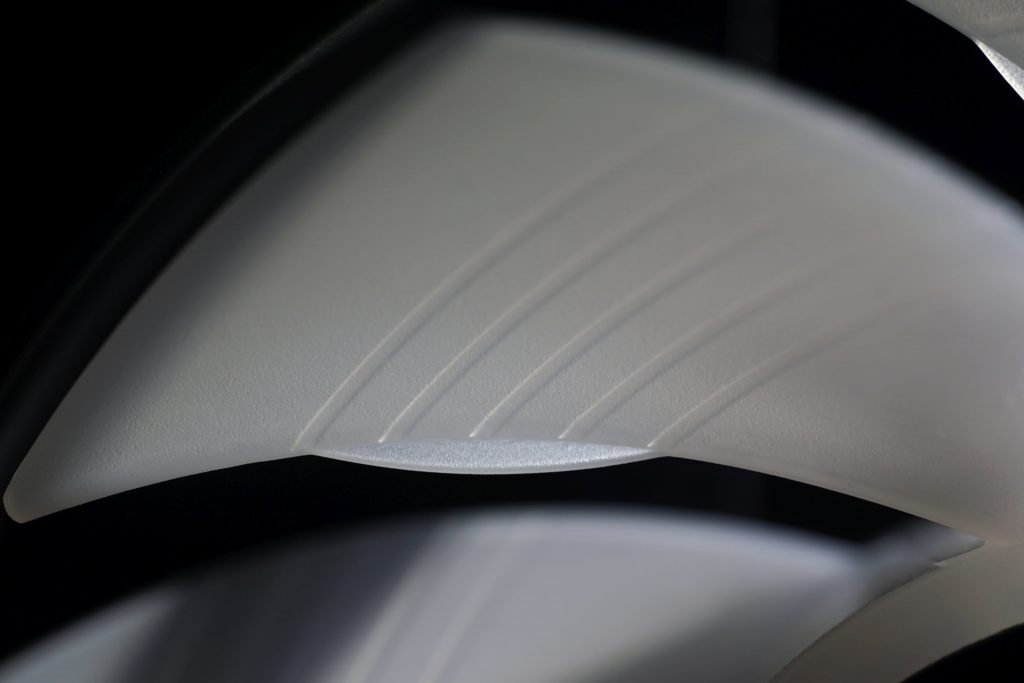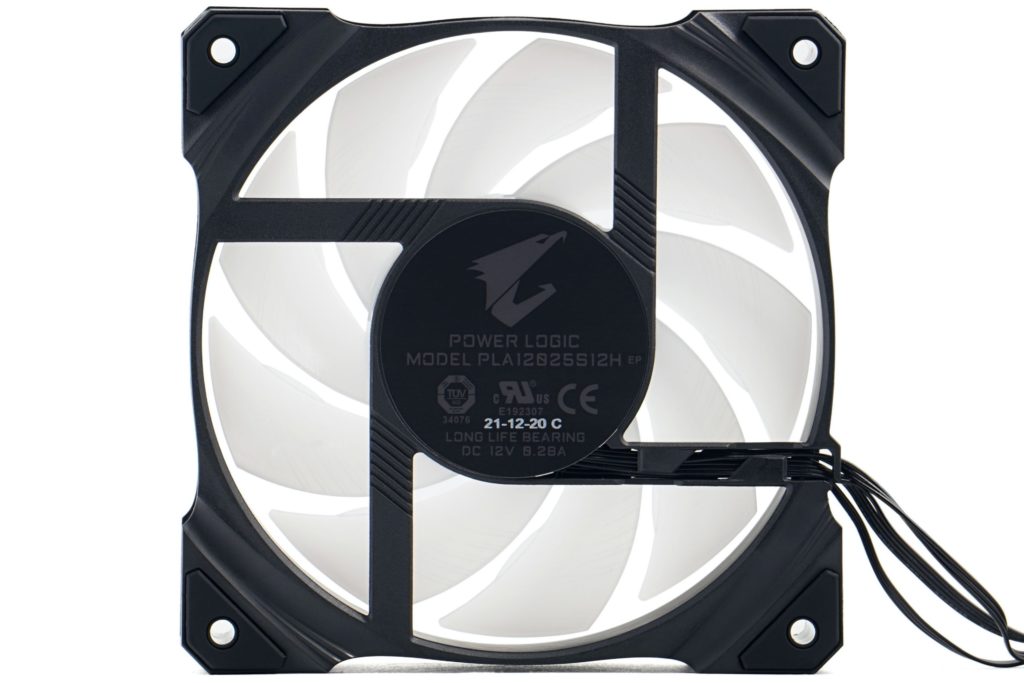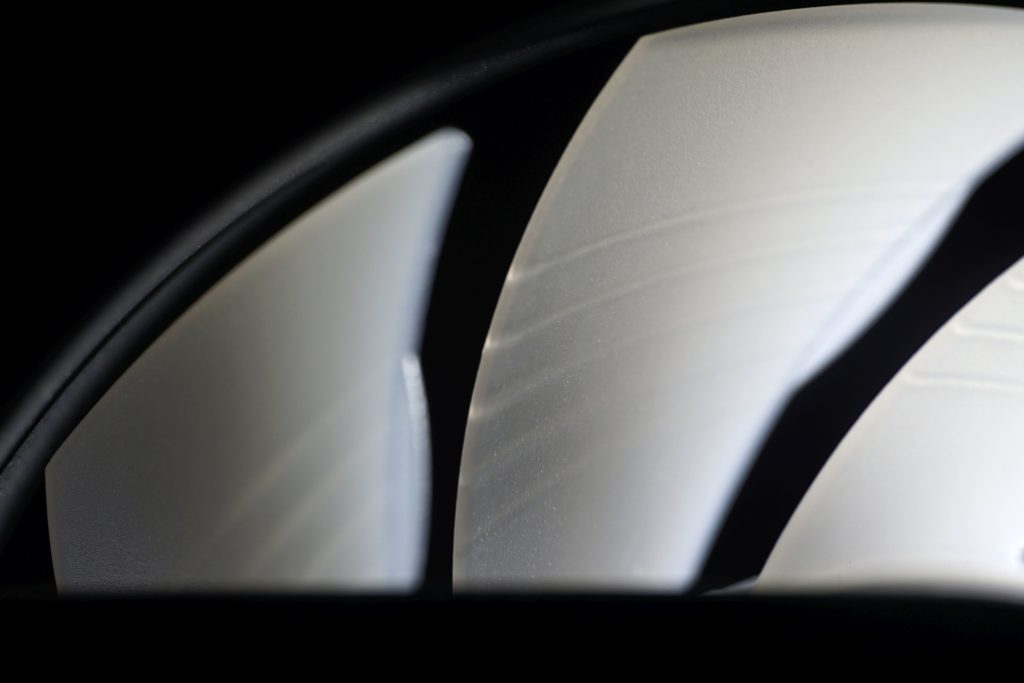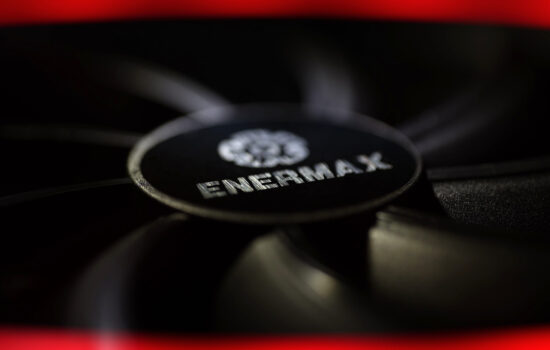Gigabyte Aorus 120 ARGB
Gigabyte’s new fan stands out from the crowd of flashy, inefficient PC components. The Aorus 120 ARGB may entice the user with its illuminated rotor, but the features that make a fan a fan don’t play second fiddle either. Although there is still room for tuning and improvement, the Aorus 120 ARGB excels in many ways and beats even competing models from traditional fan manufacturers in some areas of application.
In addition to Asus and MSI, last year, Gigabyte introduced its first fans for separate sale. Thus, we may see rivalry between the largest motherboard manufacturers in this segment as well.
Gigabyte fans come in two formats, 120 and 140 mm. For this test we will analyze the Aorus 120 ARGB, we will cover the larger one some other time. Compared to the Asus ROG Strix XF120 and MSI Silent Gale P12 fans, only the Aorus 120 ARGB has illumination. The rotor is made of a milky material with good light-conducting properties. Unlike the last tested Arctic BioniX P120 A-RGB (with a ring light guide around the rotor), this fan shines over a larger area and its brightness is also higher. Compared to the Cooler Master SickleFlow 120 ARGB, which also has light-conducting blades, it is significantly lower though. However, the LED luminosity is still high enough that some might even dim it.
Incidentally, the use of softer and more flexible material, which is subject to more of certain deformations in flight, is also related to the light-conducting blades. Naturally, these also affect the aerodynamics and acoustics of the fan.
The rotor consists of a slightly above-standard number of blades, there are nine of them. Clearly the largest dimension they have is in length, and within their geometry they also work with a non-violent curvature. With respect to the axis of the rotor, they are at a roughly 45-degree angle, which is typical for fans also suitable for cooler heatsinks.
Approximately in the middle of each blade is a 14 mm wide arch-shaped protrusion at the leading edge, behind which thin (0.6 mm) grooves extend across the entire width of the blades. These are also protruding, and the whole thing is designed to increase the dynamic pressure a bit, or to speed up the airflow.
The fan format is 120 mm with a traditional 25 mm frame thickness. This is extended by 2 mm in the corners (to a final 27 mm) by anti-vibration pads. They probably could have been softer, but we won’t criticize this fan for that. Their presence is rather unimportant for the design of the fan. In fact, the Aorus 120 has up to six stator slots, which is a rarity among ARGB LED fans. This is a rather rare detail, thanks to which lower friction is achieved and thus less force is enough to achieve the same speed than with 4-slot fans. The advantage is naturally especially in the low starting speed.
Although Gigabyte lists 800 rpm as the lower limit in the specs, it’s actually significantly less. Start-up speed is only around 275 rpm with the fan being able to be slowed down to around 180rpm. Lower speeds, with less PWM intensity, are already unstable (fluctuating). But even this is a very good result. Above-standard low friction is also supposed to be in the bearings, due to the lubricant containing graphene particles. Despite the fact that only sleeve bearings are used (with a typical mean time between failures quoted at around 40,000 hours), the MTBF is up to 75,000 hours. This is precisely because of the lower stress between the friction surfaces.
The fan cabling is extra long (45 cm) and there are three connectors. One PWM and two 5 V (3-pin) to ARGB LEDs, one of which is used for serial connection. In the table below you will then find the basic parameters compared to the fans already tested. The test results are traditionally in the following sections of the article.
| Brand and model of fan | Paper specicifations * | Price [EUR] | ||||||||
| Format (and thickness) in mm | Connecting | Speed [rpm] | Airflow [m3/h] | Static pressure [mm H2O] | Noise level [dBA] | Bearings | MTBF [h] | |||
| Motor | RGB LED | |||||||||
| Gigabyte Aorus 120 ARGB | 120 (25) | 4-pin (PWM) | 3-pin (5 V) | 800–1700 | 31.47–69.40 | 0.37–1.48 | 7.3–28.6 | sleeve | 73 500 | 25 |
| Arctic BioniX P120 A-RGB | 120 (30) | 4-pin (PWM) | 3-pin (5 V) | 400–2300 | 81.55 | 2.10 | 33.4 | fluid | N/A | 21 |
| Akasa OTTO SF12 | 120 (25) | 4-pin (PWM) | N/A | 0–2000 | 164.84 | 3.59 | 7.1–31.7 | ball | 80 000 | 22 |
| Cooler Master SickleFlow 120 ARGB | 120 (25) | 4-pin (PWM) | 3-pin (5 V) | 680–1800 | 105.34 | 2.50 | 8.0–27.0 | rifle | 160 000 | 15 |
| Alphacool SL-15 PWM | 120 (15) | 4-pin (PWM) | N/A | 600–1800 | 71.40 | 1.20 | 32.0 | ball | 50 000 | 11 |
| Arctic BioniX F120 | 120 (25) | 4-pin (PWM) | N/A | 200–1800 | 117.00 | 2.10 | 20.0 | fluid | N/A | 10 |
| SilverStone SST-AP123 | 120 (25) | 3-pin (DC) | N/A | 1500 | 96.84 | 1.46 | 23.8 | fluid | 50 000 | 25 |
| Noctua NF-P12 redux-1700 PWM | 120 (25) | 4-pin (PWM) | N/A | 400–1700 | 120.20 | 2.83 | 25.1 | SSO | 150 000 | 13 |
| SilentiumPC Fluctus 120 PWM | 120 (25) | 4-pin (PWM) | N/A | 300–1800 | N/A | N/A | N/A | fluid | 100 000 | 12 |
| MSI MEG Silent Gale P12 | 120 (25) | 4-pin (PWM) | N/A | 0–2000 | 95.48 | 2.21 | 22.7 | hydrodynamic | 50 000 | 31 |
| Asus ROG Strix XF120 | 120 (25) | 4-pin (PWM) | N/A | 1800 | 106.19 | 3.07 | 22.5 | „MagLev“ | 400 000 | 23 |
| Akasa Vegas X7 | 120 (25) | 4-pin (PWM) | 4-pin (12 V) | 1200 | 71.19 | N/A | 23.2 | fluid | 40 000 | 11 |
| Reeven Coldwing 12 | 120 (25) | 4-pin (PWM) | N/A | 300–1500 | 37.54–112.64 | 0.17–1.65 | 6.5–30.4 | sleeve | 30 000 | 12 |
| Reeven Kiran | 120 (25) | 4-pin (PWM) | shared | 400–1500 | 110.10 | 2.95 | 33.6 | fluid | 120 000 | 17 |
| SilentiumPC Sigma Pro 120 PWM | 120 (25) | 4-pin (PWM) | N/A | 500–1600 | 79.00 | N/A | 15.0 | hydraulic | 50 000 | 7 |
| SilentiumPC Sigma Pro Corona RGB 120 | 120 (25) | 4-pin (PWM) | 4-pin (12 V) | 1500 | 56.58 | N/A | N/A | hydraulic | 50 000 | 12 |
| SilverStone SST-AP121 | 120 (25) | 3-pin (DC) | N/A | 1500 | 60.08 | 1.71 | 22.4 | fluid | 50 000 | 18 |
| SilverStone SST-FQ121 | 120 (25) | 7-pin (PWM) | N/A | 1000–1800 | 114.68 | 0.54–1.82 | 16.4–24.0 | PCF (fluid) | 150 000 | 20 |
| Xigmatek XLF-F1256 | 120 (25) | 3-pin (DC) | N/A | 1500 | 103.64 | N/A | 20.0 | „long-life“ | 50 000 | 16 |
* When reading performance values, a certain amount of tolerance must always be taken into account. For maximum speeds, ±10 % is usually quoted, minimum speeds can vary considerably more from piece to piece, sometimes manufacturers will overlap by as much as ±50 %. This must then also be adequately taken into account for air flow, static pressure and noise levels. If only one value is given in a table entry, this means that it always refers to the situation at maximum speed, which is achieved at 12 V or 100 % PWM intensity. The manufacturer does not disclose the lower limit of the performance specifications in its materials in that case. The price in the last column is always approximate.
- Contents
- Gigabyte Aorus 120 ARGB
- The basis of the methodology, the wind tunnel
- Mounting and vibration measurement
- Initial warm-up and speed recording
- Base 7 equal noise levels…
- .. and sound color (frequency characteristic)
- Static pressure measurement…
- … and airflow
- Everything changes with obstacles
- How we measure power draw and motor power
- Measuring the intensity (and power draw) of lighting
- Results: Speed
- Results: Airlow w/o obstacles
- Results: Airflow through a nylon filter
- Results: Airflow through a plastic filter
- Results: Airflow through a hexagonal grille
- Results: Airflow through a thinner radiator
- Results: Airflow through a thicker radiator
- Results: Static pressure w/o obstacles
- Results: Static pressure through a nylon filter
- Results: Static pressure through a plastic filter
- Results: Static pressure through a hexagonal grille
- Results: Static pressure through a thinner radiator
- Results: Static pressure through a thicker radiator
- Results: Static pressure, efficiency by orientation
- Reality vs. specifications
- Results: Frequency response of sound w/o obstacles
- Results: Frequency response of sound with a dust filter
- Results: Frequency response of sound with a hexagonal grille
- Results: Frequency response of sound with a radiator
- Results: Vibration, in total (3D vector length)
- Results: Vibration, X-axis
- Results: Vibration, Y-axis
- Results: Vibration, Z-axis
- Results: Power draw (and motor power)
- Results: Cooling performance per watt, airflow
- Results: Cooling performance per watt, static pressure
- Airflow per euro
- Static pressure per euro
- Results: Lighting – LED luminance and power draw
- Results: LED to motor power draw ratio
- Evaluation





